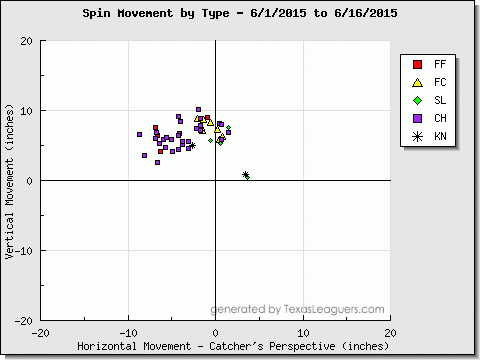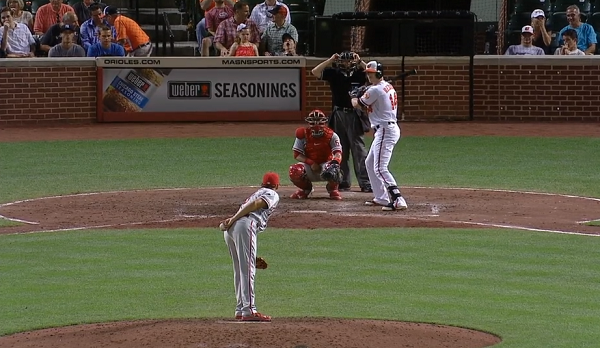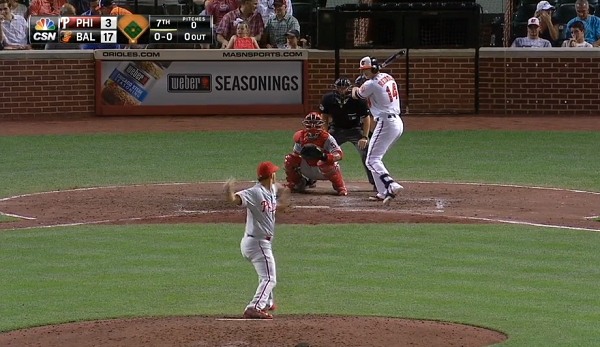Jeff Francoeur and Non-Pitchers Pitching In the Game Today
There seems to be an urge to consider Jeff Francoeur‘s Tuesday pitching appearance symbolic. Francoeur’s an outfielder called on to pitch, and he went two innings in a blowout because the bullpen phone was off the hook, and at one point he had to reassure a coach on the field he still had something left in the tank. Superficially, it seems appropriate for this 2015 Phillies major-league train wreck. I’m not totally sold, though. For one thing, communication mishaps can happen to good teams. And for another, has this really been that much of a catastrophe? The Phillies suck, but the Phillies were expected to suck, with our preseason projections calling them the worst club in baseball. This was unavoidable. But, Cole Hamels has been healthy and good. Jonathan Papelbon has been healthy and good. Maikel Franco‘s been good. Down below, J.P. Crawford‘s been good. Aaron Nola’s been good. There are things going right, here, even while the team loses game after game. Winning wasn’t ever going to be the point. Being able to win again soon is the point.
Maybe I’m taking it too seriously, though. Maybe you’re not supposed to think about it too long. And besides, the state of the Phillies is a different conversation. It’s a bigger conversation. The conversation people want to have right now is more about Jeff Francoeur. How long have we wanted to see Jeff Francoeur pitch? He finally did it, and on a day that two other non-pitchers pitched, in a whole other game.
Francoeur had never before pitched in the majors. However, not only did he pitch in high school — he also pitched just last season in Triple-A, and he pitched eight times. He even had more strikeouts than walks. So this was sort of a first and sort of not, but it’s not hard to see why it was so exciting. Francoeur’s best trait is probably his arm. That’s the reputation, and that’s your consensus. Looking at the Fan Scouting Report results from 2010 – 2014, here are the top names in average arm-strength rating:
- Andrelton Simmons (92)
- Yadier Molina (92)
- Bryce Harper (91)
- Jeff Francoeur (91)
A lot of the strongest position-player arms in baseball belong to players too valuable to put on the mound. One of them belongs to Jeff Francoeur, so we finally got to see what that was like in a game the Orioles had turned into a laugher. Francoeur achieved some decent velocity:
And the first batter Francoeur ever officially faced struck out on three pitches.
You notice that little wrinkle? Here’s a plot from Texas Leaguers, demonstrating that Francoeur tossed the occasional secondary pitch.
This would be described as a sinker-slider righty reliever. His control could stand to be better, but then, of which sinker-slider relievers couldn’t that be said? For Jeff Francoeur, there was a fastball sign…
…and a breaking-ball sign:
It’s hard to see, but it’s there, with Carlos Ruiz playing along with a two-touchdown deficit. If you already have a non-pitcher on the mound, you might as well try to make the most of it, and Francoeur was the author of the only half-inning in the game in which the Orioles didn’t score. Not that Ruiz was too particular about calling pitch location:
But he did brace himself for a two-strike breaking ball low and away (that wound up not away at all):
Francoeur didn’t throw just the scoreless inning. Again, the phone mishap. He also threw a scored inning, in the bottom of the eighth, and by the time he was finished he’d worked through 11 hitters. This is highly uncommon for a position player on the mound. Most frequently, they’re given single-inning assignments, and the last position player to face at least 11 hitters was Joe Mather in 2010. But then, Mather was handed the 19th and 20th innings. The last position player to face at least 11 hitters in an ordinary game was David Howard in 1994. Howard worked the 8th and 9th in a game his team lost 22-11. Somehow that game didn’t even last three and a half hours.
It was in the 8th that Francoeur channeled his inner big-leaguer. Step one: cough up a dinger.
Step two: hit a guy with the very next pitch.
Francoeur wore down. He was aware of it, his coaches were aware of it, and Chase Utley was aware of it. That’s what happens when you push past 20 pitches and your arm is trained for the occasional 200-foot relay. In the 7th inning, Francoeur threw two-thirds of his pitches for strikes. In the 8th inning, he dropped below half. Interestingly, though, Francoeur didn’t seem to have a marked drop in arm slot. His second pitch, and the one thrown with the greatest velocity:
The last pitch:
Elbow in the same place. Francoeur had just enough in him. Presumably no more than that. There was some risk that Francoeur could hurt himself doing something unfamiliar and doing it for two whole innings, but the risk of one game shouldn’t be exaggerated, and also, at the end of the day, we’re talking about Jeff Francoeur’s elbow and the 2015 Phillies.
For fun, I decided to run through some pitch comps, which I haven’t done for a few months now. Right or wrong, Brooks Baseball determines that Francoeur threw both a four-seamer and a sinker. The two strongest comps for his four-seamer, among current righties: Jered Weaver and Shaun Marcum. The strongest comps for his sinker: Marcum, Kyle Hendricks, and Kevin Correia. Francoeur might not have big-league control, and he might not have a big-league secondary pitch, but as non-pitchers go, at least he can start from a fringe big-league-fastball foundation. With practice, he could probably get grounders.
That about wraps up Francoeur, and memories of his appearance will fade in time. If he pitches again, it’ll be less exciting — it’s never as exciting as the debut. But he wasn’t the only non-pitcher on the mound Tuesday. Wilson Ramos boosted his season slugging percentage 31 points because he homered against both Jake Elmore and Nick Franklin in Tampa Bay. As you’d guess, it’s also highly uncommon for a team to use a pair of non-pitcher pitchers in a game that doesn’t stretch for too many innings. And this reminds us of an incredibly subtle trend: an increase in non-pitchers pitching.
With the help of the Baseball-Reference Play Index, here are the total appearances every year going back to 1950. The 2015 rate is projected forward. I had to manually strip away appearances belonging to guys like Brooks Kieschnick and Rick Ankiel, who confuse the search query. Kieschnick, for example, was a two-way player. And Ankiel had his career go in phases. The numbers might not be perfectly accurate, but they ought to be close.
Last year set a new high, and this year is on pace to exactly equal that mark. The samples are so small that the trend hardly matters, and in fact maybe there’s not a trend at all. But you could explain one, given modern reliever specialization. And perhaps teams are increasingly open-minded about giving the ball to a position player in a blowout, so that a reliever isn’t wasted. The risk of an injury has to be minute, especially if the position player isn’t trying to throw everything at 100%. Might be a different story if every such position player were used like Jeff Francoeur was on Tuesday, but that hasn’t been the case. And Francoeur sounds like he’s fine.
He’s probably even giddy. He’s pitched in the majors, he’s worked a scoreless inning, and he has a strikeout to his name. The Phillies, ever so fleetingly, did manage to achieve something fun. They just had to be losing by 14 runs.
Jeff made Lookout Landing a thing, but he does not still write there about the Mariners. He does write here, sometimes about the Mariners, but usually not.








They should turn him into a ROOGY (right-handed one out guy), and make him even more versatile! Too bad he won’t count as P in fantasy land though. He looked decent enough in that outing.